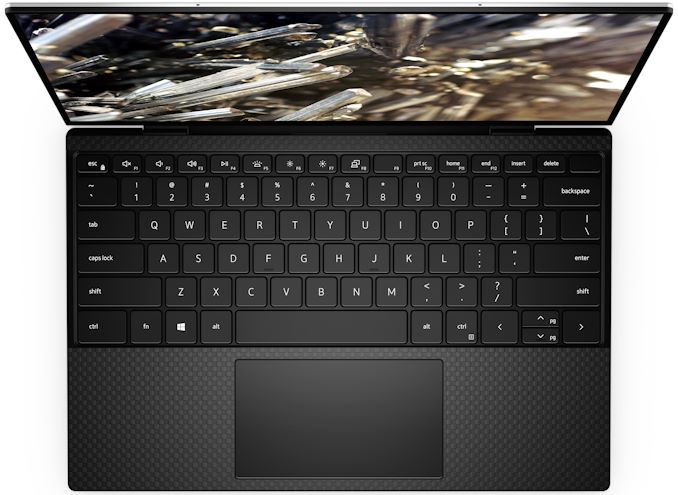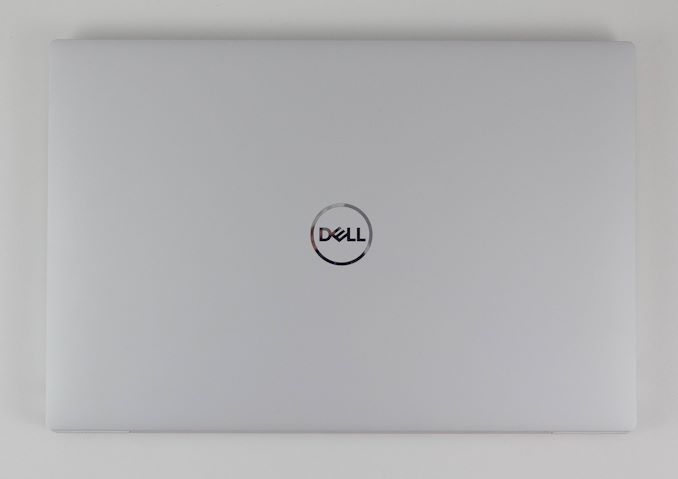The Dell XPS 13 (9300) Review: Return of the King
by Brett Howse on July 16, 2020 10:00 AM ESTDesign
Dell pioneered the thin-bezel laptop, but that does not mean they did not have room to improve on their original design over the years. The first several generations featured a webcam at the bottom of the panel, which was flattering to no one. With the proliferation of video chat, such a decision would be a major negative to many people. But thankfully Dell solved that particular issue a couple of generations ago, and the new model continues to pack a 720p webcam in the correct location above the display, with only a slightly taller top display bezel to accommodate the camera. And speaking of the display bezel, Dell has tweaked their design language slightly over the XPS 13 2-in-1, with both the black and white models both featuring a black display bezel on the clamshell XPS 13, which helps it disappear into the background a bit easier than the white bezel on the 2-in-1.

The XPS 13 in Platinum Silver with black carbon fiber
Another nice change over the 2-in-1 version is that Dell is not using their MagLev keyboard design, instead outfitting the XPS 13 with a more traditional scissor-switch keyboard with 1.0 mm of travel. The MagLev has a very short throw, whereas I find the traditional keyboard to be much more reassuring to use.
Dell is offering the XPS 13 in the same color choices as the 2-in-1 as well. The Platinum Silver model features a black carbon fiber keyboard deck with a soft-touch coating, while the Arctic White model features a woven fiber keyboard deck which Dell has treated with a stain and UV resistant coating, to prevent the deck from yellowing with age. The Arctic White is only $49 more, and certainly makes a statement, although it still suffers from the same issue as all white-on-white laptops with white backlighting, which is that the keyboard backlighting can wash out the keys in a bright room. That is a fairly minor negative though, for an otherwise fantastic finish.
The XPS 13 also features an excellent trackpad, offering a very smooth finish, and good precision. Laptop trackpads have come a long way, and part of that is the standardization on the Microsoft Precision touchpad drivers, which Dell employs here.
Dell has eschewed the use of USB Type-A ports, instead offering just a single USB Type-C port on each side of the laptop. This in turn is paired with a 3.5 mm headset jack on the right, and a micro SD card reader on the left. Although the XPS 13 lacks ports in numbers, it somewhat makes up for that with both USB ports supporting Thunderbolt 3, including power delivery. It is unfortunate that the Type-C port has found itself to be so confusing in its capabilities, but with the XPS 13 supporting the full range of protocols, as well as four lanes of PCIe on both ports, that at least is not a liability here. Dell does include a Type-C to Type-A adapter in the box as well, for those that require the larger port. By including power delivery on both sides of the laptop, that also means the XPS 13 can charge on either side, which can be very handy when moving the laptop from place to place.
Dell’s design ethos with their XPS lineup has converged across the entire range of XPS laptops, and with great success. The CNC milled aluminum bodies, thin bezels, compact designs, and lightweight chassis make for some of the most compelling devices in the industry. Moving to a 16:10 aspect ration on their XPS line has been yet another design win for Dell, and helps provide the excellent 91.5% screen to body ratio found on this XPS 13 notebook by further shrinking the bottom bezel. Dell has sculpted a clean, sleek, and functional device, and while the rest of the industry has also adopted the thin-bezel design, Dell has really mastered it.













224 Comments
View All Comments
Alistair - Thursday, July 16, 2020 - link
I own a XPS15 which had two main problems. Crappy Wifi chip (swap out for new Intel one, fixed) and bad cooling (can't fix, it is amazing how low my clock speeds went during gaming, buy a Ryzen 4700 Asus laptop and it is almost twice as fast because of thermals and better cooling). Mostly I want an XPS13 with AMD inside and I'll give it another shot. My $3000 XPS15 sits doing nothing, beaten by my $1500 Asus Ryzen 4000 laptop. G15.Shmee - Friday, July 17, 2020 - link
I looked at this, and I am very disappointed with anything soldered, means NON-upgradeable. Also lack of a separate GPU is also a problem. I am happy with my older, 15" MSI with the 7700HQ and GTX 1060. And upgradeable SATA 2.5" / m.2 drives, currently running an Adata SX8200 and a Samsung 850 Evo. I also have 2 SODIMM slots, can add another 16GB in if needed.Arbie - Friday, July 17, 2020 - link
My XPS13 had constant thermal problems that took months to "fix" - when I finally got rid of some Intel management software AND undervolted the CPU. At last the fan stopped cycling up and down just at idle, with the CPU at 70 degC. What a nightmare and so many hours wasted. Now I read in the comments here that undervolting is being disabled in Intel updates!I won't even consider another XPS13 unless it's AMD.
Spunjji - Friday, July 17, 2020 - link
I had this issue with my first-gen Infinity-Edge Broadwell XPS13. That combined with the "contrast boosting" display-dimming feature that couldn't be disabled made it useless for what I bought it for (mobile photo editing). I got rid of it in the end.Mikad - Friday, July 17, 2020 - link
Regarding the battery life & performance. It would be interesting to see how much you lose performance if you're running the laptop without the power cord.I have a somewhat bad feeling that the latest generation of laptops have a better battery life than the previous generations mainly because the laptops slow down their CPUs more than they used to.
If we take Surface Book 2 as an example (not a new laptop but still). The CPU automatically works with lower speeds when it is unplugged. AND it is not possible to get the full speed out from the machine, no matter how you change Windows' power settings.
Brett Howse - Friday, July 17, 2020 - link
That actually sounds like a good basis for an article. Windows 10 has added a lot of power management settings which can adjust the power levels of the CPU with just a slider. Can't promise anything right away but if I have time I'll look into this.zepi - Friday, July 17, 2020 - link
From what kind of USB-C chargers does this charge from? Does it charge from 9V 2A PD-charger or just complains that charger is not powerful enough? How about some 20V 2A or whatever else there might be?alexdi - Friday, July 17, 2020 - link
Lovely chassis. Not enough to make up for the wrong CPU and the lack of a 1600p screen. I don’t want battery-sucking 4K in a 13” laptop, but I also don’t want to see pixels on my small fonts.TEAMSWITCHER - Friday, July 17, 2020 - link
There is a big problem with these devices.. The focus on thin bezels has had a negative impact on the palm rest area. It's so tiny now that the typing experience isn't very good. I suppose if you don't use it that much - it's bearable. But for heavy keyboarders ... like programmers ... I would recommend the Dell XPS 15 or 16" MacBook Pro instead. They only costs a few dollars more, but deliver a much better experience all around.Spunjji - Friday, July 17, 2020 - link
The USP of the Dell was always that it's a 13" display in a 12"-sized chassis, so the palm-rest should really be judged as such. There are a few 14"-in-13"-chassis devices out there (LG Gram 14, Matebook D, Swift 5 14) if you need more room.